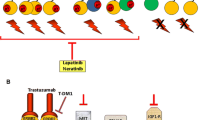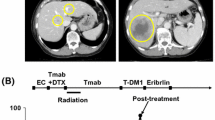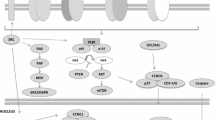Abstract
HER2 is gene amplified or over-expressed in 20–25% of breast cancers resulting in elevated HER2 activation. Trastuzumab (Herceptin), a humanized monoclonal antibody, targets activated HER2 and is clinically effective in HER2-over-expressing breast cancers. However, despite prolonged survival, treated breast cancer patients develop resistance. Resistance to trastuzumab occurs upon inactivation of HER2 regulatory proteins or upon up-regulation of alternative receptors. In particular, elevated levels of EGFR, present in estrogen receptor (ER) positive, trastuzumab-resistant BT-474 xenografts caused, a trastuzumab-resistant phenotype (Ritter et al. Clin Cancer Res 13:4909–4919, 2007). However, the role of EGFR in acquired trastuzumab resistance in ER negative cell models is not well defined. In this study, SKBR3 cell line clones expressing EGFR were generated to examine the role of EGFR over-expression on trastuzumab sensitivity in an, ER-negative breast carcinoma cell line. A stable clone, SKBR3/EGFR (clone 4) expressing moderate levels of EGFR remained sensitive to trastuzumab, whereas a stable clone, SKBR3/EGFR (clone 5) expressing high levels of EGFR, became resistant to trastuzumab. Depletion of EGFR by EGFR small-interfering RNAs in the SKBR3/EGFR (clone 5) reversed trastuzumab resistance. However, the SKBR3/EGFR (clone 5) cell line remained sensitive to lapatinib, an EGFR/HER2 inhibitor. Biochemical analysis using co-immunoprecipitation and proximity-based quantitative VeraTag assays demonstrated that high levels of EGFR phosphorylation, EGFR/EGFR homo-dimerization, and EGFR/HER2 hetero-dimerization were present in the trastuzumab-resistant cells. We conclude that EGFR over-expression can mediate trastuzumab resistance in both ER positive and ER negative cells and hypothesize that a threshold level of EGFR, in the absence of autocrine ligand production, is required to induce the resistant phenotype.









Similar content being viewed by others
References
Cho HS, Masonn K, Ramyar KX et al (2003) Structure of the extracellular region of HER2 alone and in complex with the Herceptin Fab. Nature 421:756–760
Yarden Y, Sliwkowski MX (2001) Untangling the ERBB signalling network. Nat Mol Cell Biol 2:127–137
Slamon DJ, Clark GM, Wong SG et al (1987) Human breast cancer: correlation of relapse and survival with amplification of the HER-2/neu oncogene. Science 235:177–182
Slamon DJ, Leyland-Jones B, Shak S et al (2001) Use of chemotherapy plus a monoclonal antibody against HER2 for metastatic breast cancer that overexpress HER2. N Engl J Med 344:783–792
Romond EH, Perez EA, Bryant J et al (2005) Trastuzumab plus adjuvant chemotherapy for operable HER2-positive breast cancer. N Engl J Med 353:1673–1684
Nagata Y, Lan KH, Zhou X et al (2004) PTEN activation contributes to tumor inhibition by trastuzumab, and loss of PTEN predicts trastuzumab resistance in patients. Cancer Cell 6:117–127
Ginestier C, Adelaide J, Gonclaves A, et al (2007) ERBB2 phosphorylation and trastuzumab sensitivity of breast cancer cell lines. Oncogene 26:7163–7169
Shattuck DL, Miller JK, Carraway KL et al (2008) Met receptor contributes to trastuzumab resistance of Her-2 overexpressing breast cancer cells. Cancer Res 68:1471–1477
Nahta R, Yuan LX, Zhang B et al (2005) Insulin-like growth factor-I receptor/human epidermal growth factor receptor 2 heterodimerization contributes to trastuzumab resistance of breast cancer cells. Cancer Res 65:1118–1128
Lu Y, Zi X, Zhao Y et al (2001) Insulin-like growth factor-I receptor signaling and resistance to Trastuzuman (Herceptin). J Natl Cancer Inst 93:1852–1857
Ritter CA, Marianela PT, Rinehart C et al (2007) Human breast cancer cells selected for resistance in vivo overexpress epidermal growth factor receptor and ErbB ligands and remain dependent on the ErbB receptor network. Clin Cancer Res 13:4909–4919
Prat A, Baselga J (2008) The role of hormonal therapy in the management of hormonal-receptor-positive breast cancer with co-expression of HER2. Nat Clin Pract Oncol 5:531–542
Mass RD, Vogel C, Murphy M et al (2001) Relationship of estrogen receptor (ER) status to clinical benefit in clinical trials of Herceptin. Eur J Cancer 37(suppl 6):S190
Brufsky A, Lembersky B, Schiffman K et al (2005) Hormone receptor status does not affect the clinical benefit of trastuzumab therapy for patients with metastatic breast cancer. Clin Breast Cancer 6:247–252
Sabnis G, Schayowitz A, Goloubeva O et al (2009) Trastuzumab reverses letrozole resistance and amplifies the sensitivity of breast cancer cells to estrogen. Cancer Res 69:1416–1428
Shi Y, Huang W, Tan Y et al (2009) A novel proximity assay for the detection of proteins and protein complexes: quantitation of HER1 and HER2 total protein expression and homodimerization in formalin-fixed, paraffin-embedded cell lines and breast cancer tissue. Diagn Mol Pathol 18:11–21
Desmedt C, Sperinde J, Piette F et al (2009) Quantitation of HER2 expression or HER2: HER2 dimers and differential survival in a cohort of metastatic breast cancer patients carefully selected for trastuzumab treatment primarily by FISH. Diagn Mol Pathol 18:22–29
Stommel JM, Kimmelman AC, Ying H et al (2007) Coactivation of receptor tyrosine kinase affects the response of tumor cells to targeted therapies. Science 318:287–290
Pegram MD, Lipton A, Hayes DF et al (1998) Phase II recombinant humanized anti-p185HER2/neu monoclonal antibody plus cisplatin in patients with HER2/neu-overexpressing metastatic breast cancer refractory to chemotherapy treatment. J Clin Oncol 22:2659–2671
Geyer CE, Forster J, Lindquist D et al (2006) Lapatinib plus capecitabine for HER-2 positive advanced breast cancer. N Engl J Med 355:2733–2743
Shepard FA, Periera JR, Ciuleanu T et al (2005) Erlotinib in previously treated non-small-lung cancer. N Engl J Med 353:123–132
Moore MJ, Goldstein D, Hamm J et al (2007) Erlotinib plus gemcitabine compared with gemcitabine alone in patients with advanced pancreatic cancer: a phase III trial of the National Cancer Institute of Canada clinical trials group. J Clin Oncol 25:1960–1966
Juntilla TT, Akita RW, Parsons K, et al (2009) Ligand-independent HER2/HER3/PI3K complex is disrupted by trastuzumab and is effectively inhibited by the PI3K inhibitor GDC-0941. Cancer Cell 15:429–440
Sliwkowski MX, Lofgren JA, Lewis GD et al (1999) Nonclinical studies addressing the mechanism of action of trastuzumab (herceptin). Sem Oncol 26:60–70
Kumar R, Shepard HM, Medelson J (1991) Regulation of phosphorylation of the c-erbB-2/HER2 gene product by a monoclonal antibody and serum growth factor(s) in human mammary carcinoma cells. Mol Cell Biol 11:979–986
Tao R, Maruyama I (2009) All EGF (ErbB) receptors have preformed homo- and heterodimeric structures in living cells. J Cell Biol 121:3207–3217
Yu X, Sharma KD, Takahasi T et al (2002) Ligand-independent dimer formation of epidermal growth factor receptor (EGFR) is a step separable from ligand-induced EGFR signaling. Mol Cell Biol 13:2547–2557
Narayan M, Wilken JA, Harris LN et al (2009) Trastuzumab-induced HER reprogramming in “resistant” breast carcinoma cells. Cancer Res 69:2191–2194
Zhang D, Pal A, Bornmann WG et al (2008) Activity of lapatinib is independent of EGFR expression level in HER2-overexpressin breast cancer cells. Mol Cancer Ther 7:1846–1850
Rexer BN, Ghosh R, Arteaga CL (2009) Inhibition of PI3K and MEK: it is all about combinations and biomarkers. Clin Cancer Res 15:4518–4520
Scaltriti M, Verma C, Guzman M et al (2008) Lapatinib, a HER2 tyrosine kinase inhibitor, induces stabilization and accumulation of HER2 and potentiates trastuzumab-dependent cell cytotoxicity. Oncogene 28:803–814
Acknowledgments
The authors wish to thank John Winslow and Youssouf Badal for their input on the proximity-based assays. Lili Chen helped in FACS analysis. Yining Shi and Sailaja Pidaparthi helped in the initial development of VeraTag assays. Hasan Tahir helped in the synthesis of the VeraTag reporters. Jeff Sperinde helped in setting up a method to calculate analyte concentration by slope analysis.
Author information
Authors and Affiliations
Corresponding author
Rights and permissions
About this article
Cite this article
Dua, R., Zhang, J., Nhonthachit, P. et al. EGFR over-expression and activation in high HER2, ER negative breast cancer cell line induces trastuzumab resistance. Breast Cancer Res Treat 122, 685–697 (2010). https://doi.org/10.1007/s10549-009-0592-x
Received:
Accepted:
Published:
Issue Date:
DOI: https://doi.org/10.1007/s10549-009-0592-x




